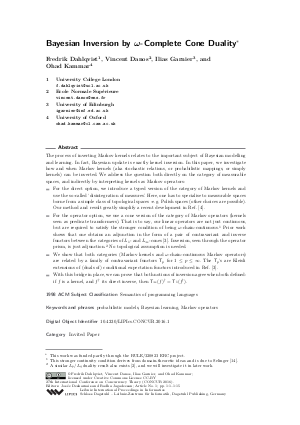Bayesian Inversion by Omega-Complete Cone Duality (Invited Paper)
Authors Fredrik Dahlqvist, Vincent Danos, Ilias Garnier, Ohad Kammar
-
Part of:
Volume:
27th International Conference on Concurrency Theory (CONCUR 2016)
Part of: Series: Leibniz International Proceedings in Informatics (LIPIcs)
Part of: Conference: International Conference on Concurrency Theory (CONCUR) - License:
 Creative Commons Attribution 3.0 Unported license
Creative Commons Attribution 3.0 Unported license
- Publication Date: 2016-08-24
File

PDF
LIPIcs.CONCUR.2016.1.pdf
- Filesize: 0.58 MB
- 15 pages
Document Identifiers
Subject Classification
Keywords
- probabilistic models
- bayesian learning
- markov operators
Metrics
- Access Statistics
-
Total Accesses (updated on a weekly basis)
0PDF Downloads0Metadata Views
Abstract
The process of inverting Markov kernels relates to the important subject of Bayesian modelling and learning. In fact, Bayesian update is exactly kernel inversion. In this paper, we investigate how and when Markov kernels (aka stochastic relations, or probabilistic mappings, or simply kernels) can be inverted. We address the question both directly on the category of measurable spaces, and indirectly by interpreting kernels as Markov operators: - For the direct option, we introduce a typed version of the category of Markov kernels and use the so-called "disintegration of measures". Here, one has to specialise to measurable spaces borne from a simple class of topological spaces -e.g. Polish spaces (other choices are possible). Our method and result greatly simplify a recent development in Ref. [4]. - For the operator option, we use a cone version of the category of Markov operators (kernels seen as predicate transformers). That is to say, our linear operators are not just continuous, but are required to satisfy the stronger condition of being $\om$-chain-continuous. Prior work shows that one obtains an adjunction in the form of a pair of contravariant and inverse functors between the categories of $L_1$- and $L_\infty$-cones [3]. Inversion, seen through the operator prism, is just adjunction. No topological assumption is needed. - We show that both categories (Markov kernels and $\om$-chain-continuous Markov operators) are related by a family of contravariant functors $T_p$ for $1\leq p\leq\infty$. The $T_p$'s are Kleisli extensions of (duals of) conditional expectation functors introduced in Ref. [3]. - With this bridge in place, we can prove that both notions of inversion agree when both defined: if $f$ is a kernel, and $f\dg$ its direct inverse, then $T_\infty(f)\dg=T_1(f\dg)$.
Cite As Get BibTex
Fredrik Dahlqvist, Vincent Danos, Ilias Garnier, and Ohad Kammar. Bayesian Inversion by Omega-Complete Cone Duality (Invited Paper). In 27th International Conference on Concurrency Theory (CONCUR 2016). Leibniz International Proceedings in Informatics (LIPIcs), Volume 59, pp. 1:1-1:15, Schloss Dagstuhl – Leibniz-Zentrum für Informatik (2016)
https://doi.org/10.4230/LIPIcs.CONCUR.2016.1
BibTex
@InProceedings{dahlqvist_et_al:LIPIcs.CONCUR.2016.1,
author = {Dahlqvist, Fredrik and Danos, Vincent and Garnier, Ilias and Kammar, Ohad},
title = {{Bayesian Inversion by Omega-Complete Cone Duality}},
booktitle = {27th International Conference on Concurrency Theory (CONCUR 2016)},
pages = {1:1--1:15},
series = {Leibniz International Proceedings in Informatics (LIPIcs)},
ISBN = {978-3-95977-017-0},
ISSN = {1868-8969},
year = {2016},
volume = {59},
editor = {Desharnais, Jos\'{e}e and Jagadeesan, Radha},
publisher = {Schloss Dagstuhl -- Leibniz-Zentrum f{\"u}r Informatik},
address = {Dagstuhl, Germany},
URL = {https://drops.dagstuhl.de/entities/document/10.4230/LIPIcs.CONCUR.2016.1},
URN = {urn:nbn:de:0030-drops-61909},
doi = {10.4230/LIPIcs.CONCUR.2016.1},
annote = {Keywords: probabilistic models, bayesian learning, markov operators}
}
Author Details
References
-
C. Aliprantis and K. Border. Infinite dimensional analysis, volume 32006. Springer, 1999.

-
C. Badescu and P. Panangaden. Abstract Markov processes with L_p spaces. Private communication, 2012.

-
P. Chaput, V. Danos, P. Panangaden, and G. Plotkin. Approximating Markov Processes by averaging. Journal of the ACM, 61(1), January 2014. 45 pages.

-
J. Culbertson and K. Sturtz. A categorical foundation for Bayesian probability. Applied Categorical Structures, pages 1-16, 2012.

-
F. Dahlqvist, V. Danos, and I. Garnier. Giry and the machine. Feb 2016. To appear in the proceedings of MFPS XXXII.

-
V. Danos, J. Desharnais, F. Laviolette, and P. Panangaden. Bisimulation and cocongruence for probabilistic systems. Information and Computation, 204(4):503-523, 2006.

-
V. Danos and I. Garnier. Dirichlet is natural. Electronic Notes in Theoretical Computer Science, 319:137 - 164, 2015. MFPS XXXI.

-
C. Dellacherie and P.A. Meyer. Probabilities and Potential, C: Potential Theory for Discrete and Continuous Semigroups. North-Holland Mathematics Studies. Elsevier Science, 2011.

-
M. Giry. A categorical approach to probability theory. In Categorical Aspects of Topology and Analysis, number 915 in Lecture Notes In Math., pages 68-85. Springer-Verlag, 1981.

-
O. Kallenberg. Foundations of Modern Probability. Springer, 1997.

-
A. S. Kechris. Classical descriptive set theory, volume 156 of Graduate Text in Mathematics. Springer, 1995.

-
D. Kozen. Semantics of probabilistic programs. Journal of Computer and System Sciences, 22(3):328-350, 1981.

-
S. Mac Lane. Categories for the Working Mathematician, volume 111 of Graduate Texts in Mathematics. Springer, 1998.

-
P. Selinger. Towards a semantics for higher-order quantum computation. In Proceedings of the 2nd International Workshop on Quantum Programming Languages, TUCS General Publication, volume 33, pages 127-143, 2004.

